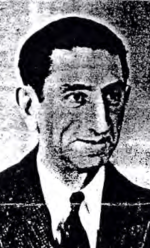 "Crime Confessions," August 1941 In the fall of 1933, Louis Gross was convicted of first-degree murder and sentenced to life in prison for the murder of Martado Abraham in Wayne County, Michigan. Fourteen years later, journalists for the magazine Argosy convinced the prosecutor at that time to re-open the investigation into the Abraham murder based on evidence that Gross had been framed; the prosecuting attorney concluded that Gross had indeed been framed for the Abraham murder and, in the fall of 1949, moved for a new trial. The court granted the motion and the prosecutor immediately moved to dismiss all charges against Gross. Gross was freed after having served sixteen years. On November 17, 1932, Martado Abraham, a Syrian immigrant, was found shot to death in his home in the suburbs of Detroit, Michigan. His stepson, Alex Abraham, discovered Martado’s body. Alex reported the crime to the Highland Park police station. Police arrested Alex for the murder. Upon further investigation, police also arrested Abraham’s widow, Zinab (also referenced as “Zamid”) Abraham and her lover, Sam Hazemy, for the murder. (There are conflicting reports concerning whether Zinab and Hazemy were arrested or merely detained for questioning and then released without arrest). Alex Abraham was released from custody after the arrest of Zinab Abraham and Hazemy. Although Zinab and Martado were separated, neighbors of the couple reported that Martado had warned Hazemy to stay away from Zinab. Hazemy and Zinab told police that 33-year-old Louis Gross was upset with Martado Abraham over a rug Gross had sold to Abraham. Apparently Abraham had refused to pay for the rug, suggesting that it was stolen. Hazemy further told police that Gross had confessed the murder to him. Gross’s criminal history (three larceny convictions) lent some credibility to this story. After these revelations, Sam Hazemy and Zinab Abraham were released from custody. Based on the information provided by Hazemy and Zinab, police arrested Louis Gross at his home on November 28, 1932. Gross denied any involvement in the murder. Rather, Gross told police, Hazemy had approached him sometime before the murder and asked him to carry out a “hit” on Martado Abraham in exchange for a gold necklace, but Gross refused. Gross also told police that he was with a poker buddy at the time of the murder. Unbeknownst to Gross, however, the poker buddy denied the alibi and, instead, told police that he saw Gross near Abraham’s home on the night of the murder. Gross was formally charged with the murder of Martado Abraham on December 7, 1932. Gross’s trial began in May 1933, but the judge declared a mistrial after three days. Gross was re-tried in September 1933. Principal evidence in the case consisted of Hazemy’s testimony as described above, testimony from another man who swore that Gross had asked him for three dollars to buy poison “to kill a man down the street,” and the testimony of a woman that Gross had offered her a few dresses to rent a room near where Abraham stored his merchandise and entice him there. The defense called Gross’s poker buddy to testify to confirm his alibi, but the prosecution introduced the friend’s previous statement regarding Gross’s whereabouts on the night of the murder. Gross was convicted of murder and sentenced to life in prison. His friend was charged with perjury but was never convicted of the crime. Gross maintained his innocence and finally convinced the prison rabbi to hear his story. He claimed he had been framed for the murder in order to protect an influential government official’s relative - likely Hazemy. The rabbi believed Gross and began working to obtain his release. The rabbi took Gross’s story to reporters for Argosy magazine, who agreed to investigate further. What they found was surprising: most of the court records regarding Gross’s case were missing, including (1) the notebooks of the court reporter covering the Gross trial; (2) all the stenographic notes the court reporter took during the Gross trial; (3) the circuit court file regarding the Gross case; and (4) several records from the prosecutor’s office concerning the Gross case. Moreover, the reporters learned that a police officer, Captain W.I. Cross, who became interested in the Gross case after several Syrian businessmen told him they believed Gross was framed, was told to “lay off” the investigation. Cross ignored the order, but was forced into retirement after he refused to cease his investigation. Cross told authorities, “I do not believe Louis Gross is guilty of this murder. I think he is as innocent as I am, and I think the real murderer is alive and walking the streets.” Upon learning of Argosy’s investigation and publications, the Wayne County prosecuting attorney, Gerald K. O’Brien, launched an investigation into the Gross case. O’Brien and his team interviewed Captain Cross as part of the investigation. O’Brien’s investigation revealed that there was sufficient probability that Louis Gross was innocent. Key factors in O'Brien's conclusion included the missing court records, the information obtained from Cross, and the thin, circumstantial evidence on which Gross’s conviction was based. O’Brien then subjected Hazemy to a lie detector test covering the veracity of his testimony at the Gross trial. Hazemy failed the test. O’Brien then moved for a new trial in October 1949. The motion was granted, and the charges were dismissed. On October 28, 1949, Gross was released after having served sixteen years in prison. - Researched by Danielle Fitzpatrick |